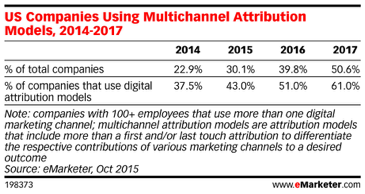
6 Ways Your Marketing Success Gets the Wrong Attribution
Napoleon Bonaparte, French political and military leader, once said “War is ninety percent information.” But, what if the information is wrong. Or formulated incorrectly?
So, today we are talking about 6 ways to truly botch up multi-channel attribution. I’ll start by saying multi-channel attribution is a complex topic, so if it is not something you are familiar with you can see our friends at Google to learn more about what it is and how to set it up for your business.
And, in case you are on the fence as to whether the “multi-channel attribution discussion” is just a passing fad, here are some interesting projections around where the conversation of attribution is going.

Before we dive in let’s level set on “attribution.” In short attribution is making sure that the right marketing channel gets the right amount of credit for a new prospective lead. According to Google an Attribution Model is “is the rule, or set of rules, that determines how credit for sales and conversions is assigned to touchpoints in conversion paths.”
So, here are the 6 ways to truly botch it up…
1. Invite the Wrong Team to the Table
To ensure chaos ensues only include a small sub-set in the initial planning meeting to discuss your attribution model and channel objectives.
What you should do instead:
- Invite one stakeholder from each channel team as well as the spoke-person for the sales team and the marketing team.
- Make sure every one is aligned on what multi-channel attribution is and what options they have in the way of models. You could even send them the link to this video to watch before the meeting.
2. Don’t Define the Attribution Model You Will Be Using
This is similar to not outlining clear objectives before beginning your efforts.
What you should do instead:
- Select a model as a team to begin using. (Reference the chart below on what most companies are using as their Primary Attribution Model.)
- Outline all of the channels that are touchpoints.
- How are people getting to your website?
- What are they doing along the way? Downloading content? Watching Webinars? Receiving emails? Where are they converting?
- How many other touchpoints do the people converting have with your company? What are they? Is there a pattern?
- Make sure you have a way to track all channels through your analytics tools.
- Use UTM codes for email marketing campaigns and social media to ensure that you can gather all the data in one place to compare information and develop better insights.

3. Tell the Story You Want to Tell vs. Letting the Data Tell the Story
Sure, the paid search numbers are really good, but that doesn’t necessarily mean you should reallocate other channel budgets to the paid search budget.
What you should do instead:
- Look through the customer conversion path and touch points to ensure that you are drilling down into how and where people are interacting with your brand.
- What’s the big picture?
- Can you test something to validate insights?
4. Don’t Look at Historical Data
Start planning without reviewing how channels have been performing to date.
What you should do instead:
- Look at the past data and apply those insights to your future planning.
- If things underperformed in past campaigns do the work to figure out why.
- Did you perform any A/B testing? What were the results? Are they applicable?
5. Make Broad Generalizations
When your social media efforts are not leading to sales someone on your team may come to the conclusion that it’s time to cut your social media budget. However, when you dive deeper you realize that social media was a great way to begin conversations with clients, but it’s not necessarily the closer.
What you should do instead:
- Understand the value of each channel as a touchpoint along the way.
- On a quarterly basis review the ROI for these channels and the support they provide to the user’s conversion path.
6. Set It and Forget It
You DID all the heavy lifting and reviewed all the insights. Now it’s time to just let everything do its thing.
What you should do instead:
- Schedule a monthly accountability meeting.
- Set an agenda where each team member is responsible for speaking in detail about the value of the users that have engaged with their channel, the insights they uncovered with this last month’s data and the optimizations they recommend.
- Once a quarter schedule a deeper dive to truly revisit whether the channels in the plan are delivering on their intended objectives.
Key Takeaways:
- Engage the right team members from the start.
- Pick the attribution model that works best for your users.
- Let the data tell the story.
- Look at your analytics history and apply that knowledge to future plans.
- Dive into the data before drawing conclusions.
- Make a monthly effort to hold one another accountable to reviewing the data, discussing insights and identifying opportunities for optimizations.
Bottom line, incorrect attribution can lead to incorrectly pausing a performing channel or sinking more money into an underperforming channel. Help your future self out and start thinking through attribution sooner than later. Win the war by cultivating an environment to draw better conclusions and insights from the information at hand.
(Looking to take the next step and discuss your marketing strategy? Learn about VI's Marketing Strategy services: here)








